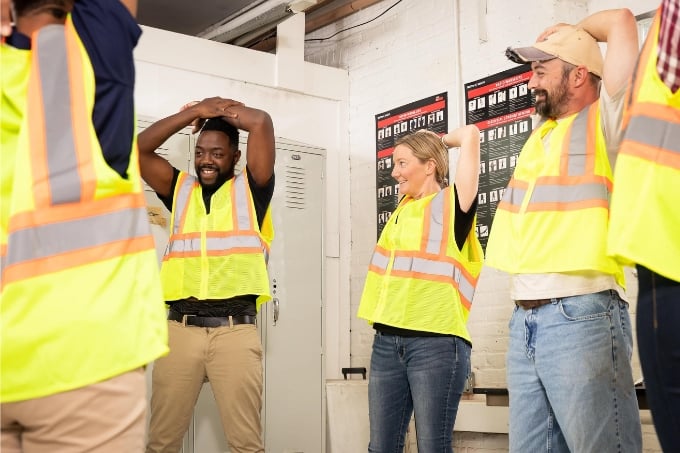
As we commemorate National Safety Month, it's crucial to bring attention to the topic of workers' health and safety, especially for construction and manufacturing workers who often face a higher risk of injury on the job site. Industrial Sports Medicine solutions are essential in fostering better occupational health. An effective approach is the implementation of a comprehensive onsite stretch and flex program to help prevent musculoskeletal injuries and disorders.
The Importance of Stretch and Flex Programs
Musculoskeletal disorders (MSDs), which affect muscles, ligaments, tendons, and bones, are a leading cause of disability among construction and manufacturing workers. These disorders often result from poor ergonomics, heavy lifting, and repeated tasks in the work environment. The consequences can range from lower back and upper back injuries to sprains and muscle strain.
According to the U.S. Bureau of Labor Statistics (2021), MSDs account for more than one-third of all lost-workday injuries and illnesses. This statistic underscores the pressing need for effective prevention strategies in the workplace.
OSHA reports that implementing an effective stretching program can significantly reduce the incidence of MSDs among workers. Not only can these programs improve range of motion and flexibility, but they also warm up the muscle groups, promoting better blood flow and minimizing the risk of soft tissue injuries. This study found that workers who participated in a daily stretching program had a 5% reduction in musculoskeletal injury rates. This data demonstrates the tangible benefits of a well-executed stretch and flex program.

Enhancing Your Onsite Stretch and Flex Program
As we raise the bar in the construction and manufacturing industries, we must focus on elevating onsite stretch and flex programs. This process involves improving the effectiveness of the programs, their participation rates, and their overall impacts on workers' well-being.
Use Ergonomic Principles
The first step in elevating your stretch and flex program is integrating ergonomic principles. Ergonomics considers how the work activity, work tasks, and work environment can be designed or modified to fit the worker. This means analyzing tasks, identifying risk factors such as heavy lifting or repetitive motions, and determining appropriate exercises to counteract these strains.
Incorporate a Daily Stretch
Incorporating a daily stretch routine at the start of the workday can have significant benefits. A warm-up that involves light cardio and flexibility exercises helps increase blood flow and warms up the muscles, reducing the risk of injury.
Focus on Common Injuries
Common injuries among workers include back injury, sprains, and strains, often affecting the lower back, upper back, and hamstring. It is essential to design the exercise program focusing on these areas, ensuring that the stretch and flex exercises target these muscle groups and ligaments.

Empowering Workers with Knowledge
Education plays a vital role in elevating the onsite stretch and flex program. Workers should be educated about the benefits of participating in these programs and how to perform the exercises correctly to reduce their risk of injury.
Understanding the Risks
Workers should understand the risk of injury associated with their jobs, from the potential for acute injuries to the cumulative damage that can occur over long periods of time from repetitive tasks. This understanding can make them more aware of the importance of prevention strategies, like participating in a stretching program.
Practicing Correct Form
For a stretching program to be effective, it's crucial for workers to use correct form. Incorrect stretching can sometimes do more harm than good, potentially leading to muscle strain or other injuries. Make sure you're learning the correct form from a trained professional.
Encouraging Participation
The success of the stretch and flex program also hinges on the level of worker participation. Encouraging participation can be achieved by making the exercises enjoyable, having team leaders join in, and rewarding consistent participation.

Measuring Success
Regular evaluations should be conducted to assess improvements in the health and well-being of workers. Metrics to consider include reductions in musculoskeletal injuries, fewer workers' compensation claims, and improved employee morale and productivity.
Tracking injury rates can provide valuable data on the effectiveness of the stretch and flex program. A reduction in the frequency and severity of these injuries over time clearly indicates program success. Occupational Health & Safety Magazine reported that companies that implemented stretching programs saw 30% reductions in lost workdays, further supporting the efficacy of these programs.
Monitoring workers' compensation claims is another key indicator of a successful safety program. A decline in these claims translates to less lost work time, lower healthcare costs, and increased productivity.
Gauging worker satisfaction through surveys and direct feedback can be a valuable tool in assessing the success of the stretch and flex program. Increased satisfaction with the work environment and tasks, improved sense of well-being, and overall job satisfaction are positive signs of an effective program.
Looking to the Future: Construction and Manufacturing Safety and Wellness
As National Safety Month reminds us, the health and safety of workers should always be at the forefront of the construction and manufacturing industries. It's critical for companies to prioritize stretching programs as part of their broader safety program and to continually look for ways to elevate these programs to new heights.
Onsite stretch and flex programs are more than just a series of exercises; they are an investment in the health and safety of workers. By incorporating ergonomic principles, focusing on common injuries, empowering workers with knowledge, and measuring success, these programs can help reduce the risk of injury and promote better occupational health.
Briotix Health, with our strong commitment to Industrial Sports Medicine, is here to support companies in their journey to improve occupational safety and health. We work closely with companies to design and implement effective onsite stretch and flex programs, making workplaces safer and healthier. We are ready to be your partner in enhancing the well-being and safety of your workers on the jobsite, one stretch at a time.
As we conclude National Safety Month, let us carry forward the message of safety and health in our workplaces throughout the year. Remember, a strong, consistent stretch and flex program can do wonders for not just the health of your workers, but for the overall success of your company. Let's take the necessary steps today to elevate these programs and make every month a Safety Month.
